Ijraset Journal For Research in Applied Science and Engineering Technology
- Home / Ijraset
- On This Page
- Abstract
- Introduction
- Conclusion
- References
- Copyright
The Effect of Government Regulations on Overall Economic Well Being in India (1995-2020)
Authors: Aditi Das, Muskan Mohan, Nitya Sultania, Ishika Yadav
DOI Link: https://doi.org/10.22214/ijraset.2022.45592
Certificate: View Certificate
Abstract
Barriers to trade and other market regulations have long been thought to inhibit the ability of a Nation’s economy to grow and prosper. We test this hypothesis using a multiple regression model and data from The Heritage Foundation and World Bank related to trade freedom and general economic regulation on a country to fully discern the impact of governmental regulation on a country’s GDP per capita. We find that GDP per capita rises significantly as a India’s business freedom and trade freedom grow. This provides strong confirmation for our hypothesis that deregulated economies experience higher levels of economic prosperity as measured by GDP per capita than their regulated counterparts and indicates that a market-specific look should be taken to fully understand the nuances of the results of different types of economic regulation.
Introduction
I. INTRODUCTION
Trade can act as a powerful engine for economic growth and development. Developing countries like India have long strived for a development strategy that will sustain high economic growth, create employment opportunities and eliminate poverty. Trade policy is being used by the developing countries as a tool for attaining their development objectives, which aim to combine higher economic growth with employment generation in order to alleviate poverty. Trade facilitation is also found to have positive effects on gross domestic product (GDP), economic welfare and government revenue.
Free trade is widely thought to be prerequisite for sustained economic success, but many countries feel the need to promote domestic production by enforcing barriers and regulations on imported goods and regulating different aspects of the economy as a whole. The same is true of regulation in other sectors of the economy, such as the labor and business markets: lawmakers are often compelled to protect the interests of various stakeholders at the expense of economic freedom. Overall, we will look at the impact of regulations and trade barriers on GDP per capita as we analyze whether the statement that completely free trade and deregulated markets are always the most beneficial for an economy is true or if regulation in some or all sectors is of help as well.
This research is important because it gives guidance as to how much is too much and how little is too little when it comes to regulations and barriers. It shows the overall, broad trend relating trade freedom and economic regulations and to GDP per capita for a country. Using data from The Heritage Foundation’s Index of Economic Freedom and the World Bank, we analyze this relation. Our study focuses on regulatory efficiency and market openness, and within this the variables trade freedom, monetary freedom, and investment freedom, and by extension; FDI. We hypothesize that the overall trend will show a positive relationship between economic freedom and economic well-being as measured by GDP per capita. This hypothesis operates off of the free market assumption that economies do best when they are left to run themselves. Thus, allowing trade, monetary, and investment to happen freely without regulations or interruption should result in the optimal economic conditions for countries.
The testing has been done using Ordinary Least Squares Method under Classical Linear Regression Model.
II. LITERATURE REVIEW
- Rajan Sudesh Ratna and Martina Francesca Ferracane: According to them there is existing literature on the contribution of trade facilitation to the enhancement of trade as well as to the promotion of GDP growth, welfare improvements and government revenue, all of which go a long way towards poverty reduction. However, the government role is found to be crucial in ensuring that the poor fully benefit from the increased trade opportunities.
- Frankel and Romer (1999): Study provides some strong evidence in favour of the relationship between trade and growth while investigating whether the correlation between openness and growth was because openness causes growth, or because countries that grow faster tend to open up at the same time. Controlling the component of the openness due to such country characteristics as population, land area, and geographic distance that cannot be influenced by economic growth, they found that an increase of one percentage point in the openness ratio increased both the level of income and subsequent growth by around 0.5 per cent.
- Nguyen Viet Cuong: The findings show that improvement in trade facilitation is positively correlated with exports and per capita GDP, and negatively correlated with poverty and inequality. More specifically, deterioration in trade facilitation – which is measured by the increase in the number of documents required and days taken for exporting and importing a good– can reduce per capita GDP, albeit to a small amount. Countries requiring a larger number of documents and more time for imports and exports tend to have higher levels of poverty and inequality (measured by the Gini index) than other countries.
- Prabir De and Ajitava Raychaudhuri: The study reveals that there are many opportunities for the poor and microenterprises to benefit from trade facilitation measures in Mukdahan and Nakhon Phanom provinces, especially in the agricultural, services and investment sectors. There is growing demand in Viet Nam and China for agricultural products, especially organic rice, tapioca, rubber, sugar and fresh fruit. Farmers and agricultural employees in the two provinces can benefit more now from trade facilitation measures by harvesting and exporting such agricultural products to Viet Nam and China via the improved road infrastructure.
III. DEPENDENT VARIABLE – GDP PER CAPITA (BILLION USD)
GDP stands for "Gross Domestic Product" and represents the total monetary value of all final goods and services produced within a country during a period of time.
GDP is the most commonly used measure of economic activity. GDP as an economic indicator is used worldwide to show the economic health of a country. For low-income or middle-income countries, high year-on-year GDP growth is essential to meet the growing needs of the population. Hence, the GDP growth rate of India is an essential indicator of the country’s economic development and progress. Besides measuring the health of the economy and helping the government in framing policies, the GDP growth rate numbers are also useful for investors in better decision-making related to investments
A. GDP per Capita
Per capita income is national income divided by population size. Per capita income is often used to measure a sector's average income and compare the wealth of different populations. Per capita income is often used to measure a country's standard of living. Per capita GDP is a global measure for gauging the prosperity of nations and is used by economists, along with GDP, to analyze the prosperity of a country based on its economic growth.
Small, rich countries and more developed industrial countries tend to have the highest per capita GDP. per capita GDP shows how much economic production value can be attributed to each individual citizen. Alternatively, this translates to a measure of national wealth since GDP market value per person also readily serves as a prosperity measure.
IV. INDEPENDENT VARIABLE – TRADE FREEDOM INDEX
Trade freedom is a composite measure of the absence of tariff and non-tariff barriers that affect imports and exports of goods and services. It measures the extent of tariff and nontariff barriers that affect imports and exports of goods and services and is calculated based on trade-weighted average tariff rate and rate of non-tariff barriers. An index of economic freedom measures jurisdictions against each other in terms of trade freedom, tax burden, judicial effectiveness, and so on.
Free and open trade has fueled vibrant competition, innovation, and economies of scale, allowing individuals and businesses to take advantage of lower prices and increased choice
International trade has occurred since the earliest civilisations began trading, but in recent years international trade has become increasingly important with a larger share of GDP devoted to exports and imports. International trade between different countries is an important factor in raising living standards, providing employment and enabling consumers to enjoy a greater variety of goods.
V. INDEPENDENT VARIABLE –MONETARY FREEDOM INDEX
Monetary freedom combines a measure of price stability with an assessment of price controls. Both inflation and price controls distort market activity. Price stability without microeconomic intervention is the ideal state for the free market.
This variable is measured on a scale from 0-100 with 100 indicating a perfectly free market and 0 indicating a completely regulated or unfree market. The score for the monetary freedom component is based on two factors: The weighted average inflation rate for the most recent three years and Price controls. Higher index values denote price stability without microeconomic intervention.
As a vital component of human dignity, autonomy, and personal empowerment, economic freedom is valuable as an end itself. Just as important, however, is the fact that monetary freedom provides a proven formula for economic progress and success. Policies that allow greater freedom in these areas measured tend to spur growth.
VI. INDEPENDENT VARIABLE – INVESTMENT FREEDOM INDEX
Investment freedom refers to constraints associated with the flow of investment capital within a country. It is generated as a composite of a nation’s treatment or screening of foreign investment, foreign investment code, restrictions on land ownership, capital controls, and other factors related to investment. This variable is measured on a scale from 0-100 with 100 indicating a perfectly free market and 0 indicating a completely regulated or unfree market.
A country having freedom from restrictions on the movement and use of investment capital, regardless of activity, within and across the country's borders, & where individuals and firms would be allowed to move their resources into and out of specific activities, both internally and across the country’s borders, without restriction. Such an ideal country would receive a score of 100 on the investment freedom component of the Index of Economic Freedom.
In practice, most countries have a variety of restrictions on investment; restrict access to foreign exchange; impose restrictions on payments, transfers, and capital transactions.
VII. DUMMY VARIABLE – FOREIGN DIRECT INVESTMENT
Foreign direct investment (FDI) is an investment from a party in one country into a business or corporation in another country with the intention of establishing a lasting interest. Lasting interest differentiates FDI from foreign portfolio investments, where investors passively hold securities from a foreign country. A foreign direct investment can be made by obtaining a lasting interest or by expanding one’s business into a foreign country.
Foreign direct investment offers advantages to both the investor and the foreign host country. These incentives encourage both parties to engage in and allow FDI.
Foreign Direct Investment (FDI) has been a major non-debt financial resource for the economic development of India. Foreign companies invest in India to take advantage of relatively lower wages, special investment privileges like tax exemptions, etc. For a country where foreign investment is being made, it also means achieving technical know-how and generating employment.
The Indian Government’s favourable policy regime and robust business environment has ensured that foreign capital keeps flowing into the country. The Government has taken many initiatives in recent years such as relaxing FDI norms across sectors such as defense, PSU oil refineries, telecom, power exchanges, and stock exchanges, among others.
VIII. EMPIRICAL ANALYSIS
A. Objective
To determine the impact of India’s Trade Freedom, Monetary Freedom, Investment Freedom, and Foreign Direct Investment on its GDP per capita (billion USD).
B. Data Source
Secondary data has been collected for all the variables from 1995-2020. Following are the sources of the data:
- The Heritage Foundation’s Index of Economic Freedom
- The World Bank
C. Methodology and Results
Multiple Linear Regression, Double Log Regression, Dummy Variable and Interactive Dummy Variable Regression using Ordinary Least Squares Method under the assumptions of Classical Linear Regression Model.
Linear Model
One Dependent And Three Explanatory Variables Multiple Linear Regression Model
- Interpretation
Effect of India’s Trade Freedom, Monetary Freedom, and Investment Freedom on its GDP per capita (billion USD)
Y: GDP per capita (billion USD) X2i : Trade Freedom (index)
X3i : Monetary Freedom (index) X4i : Investment Freedom (index)
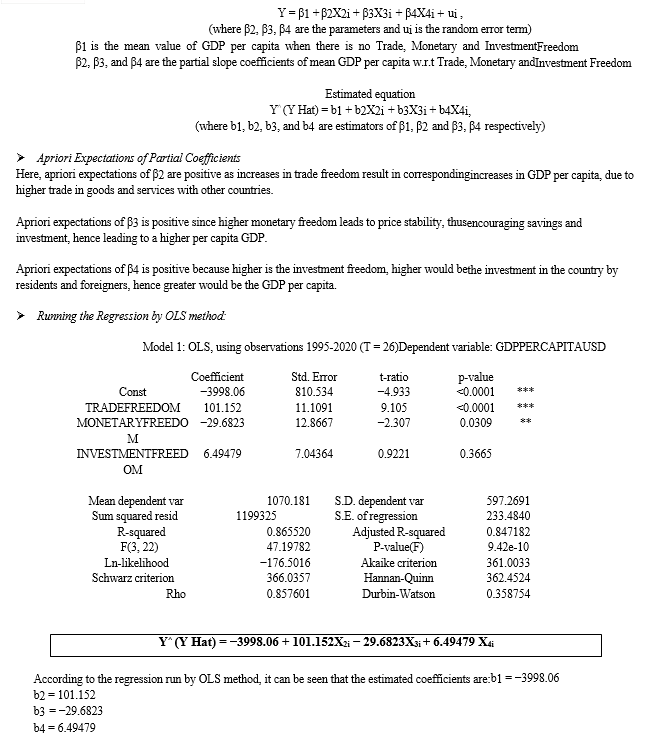
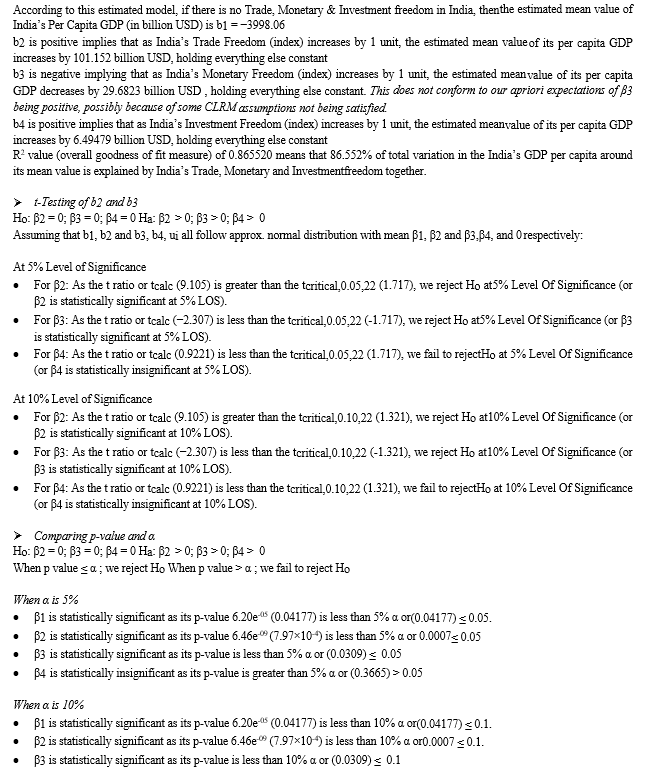
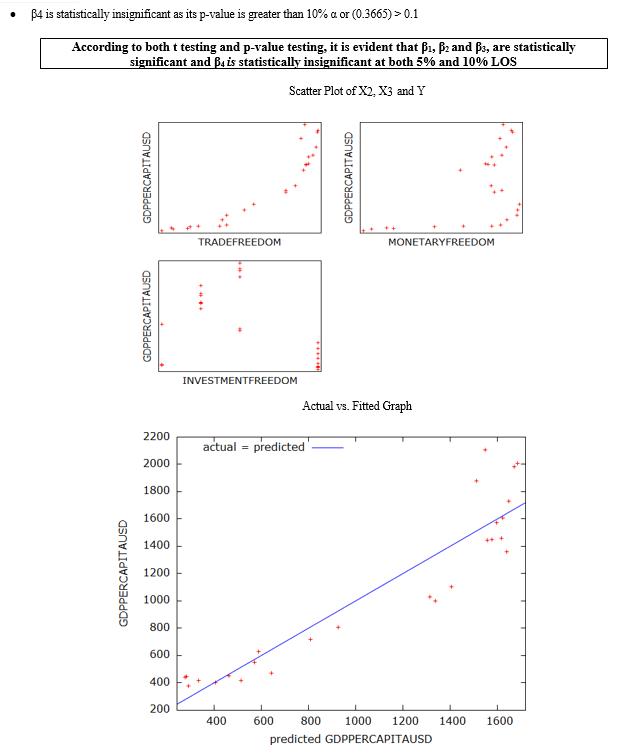

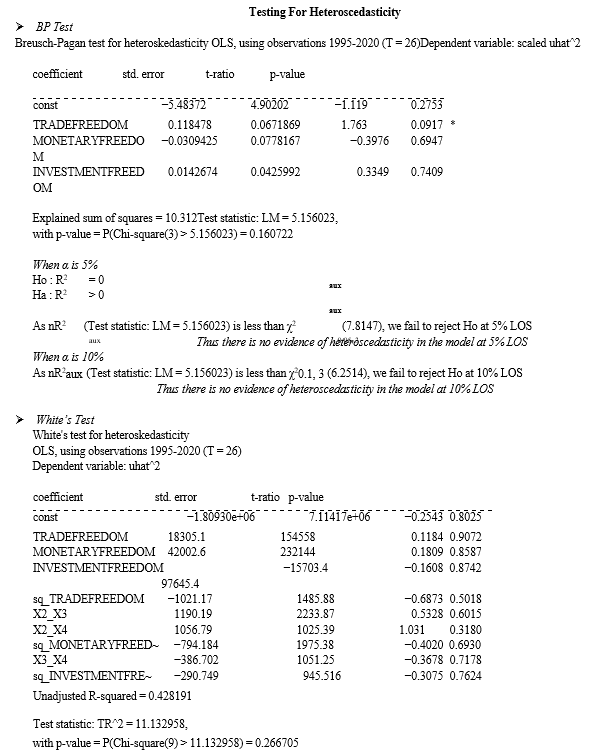
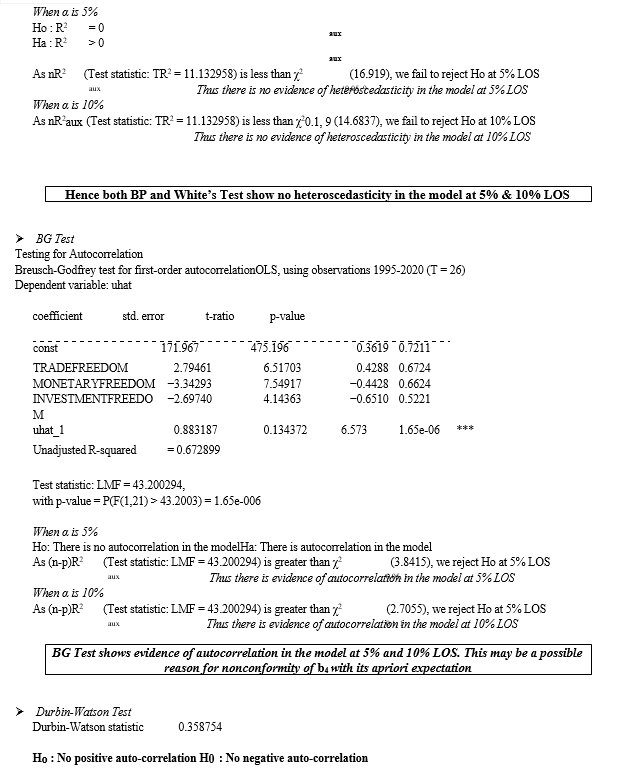
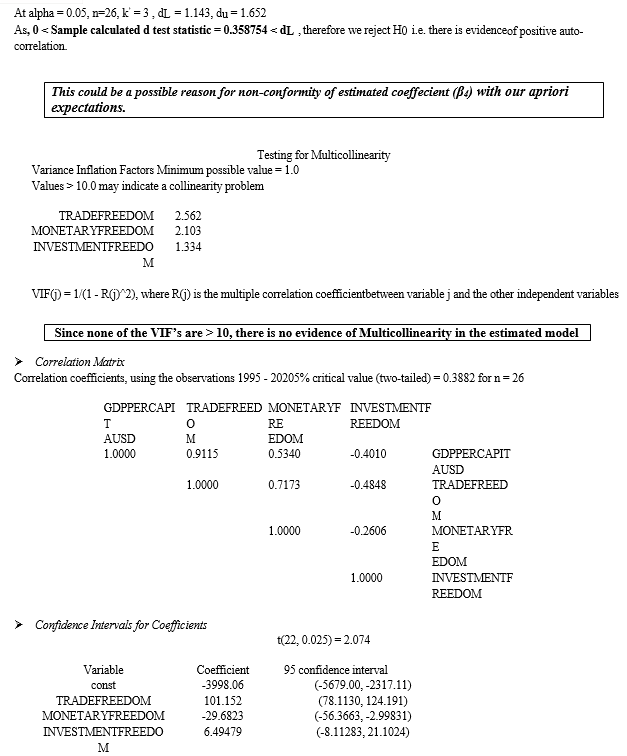
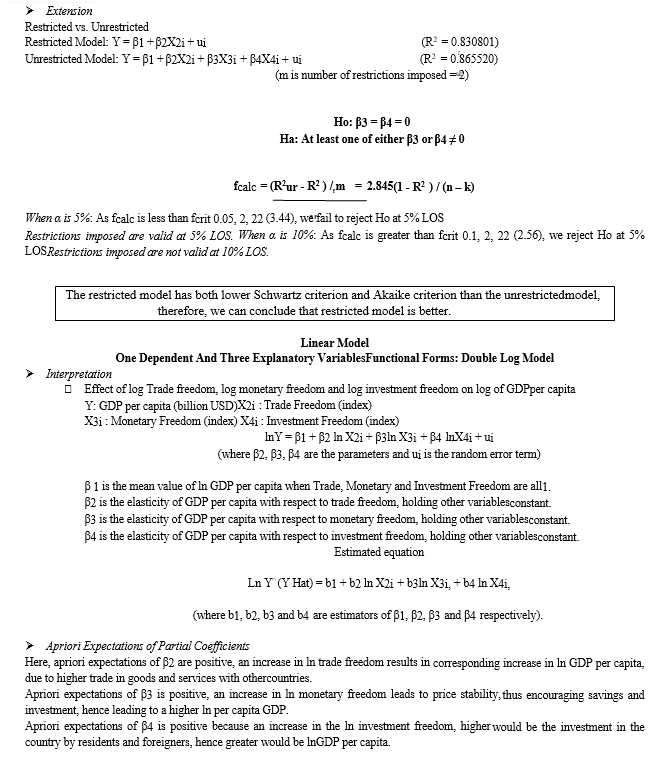

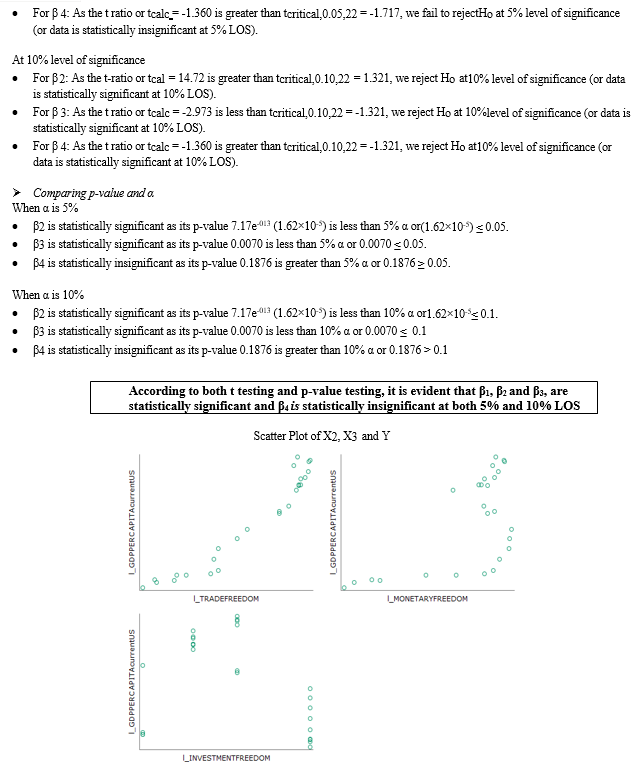

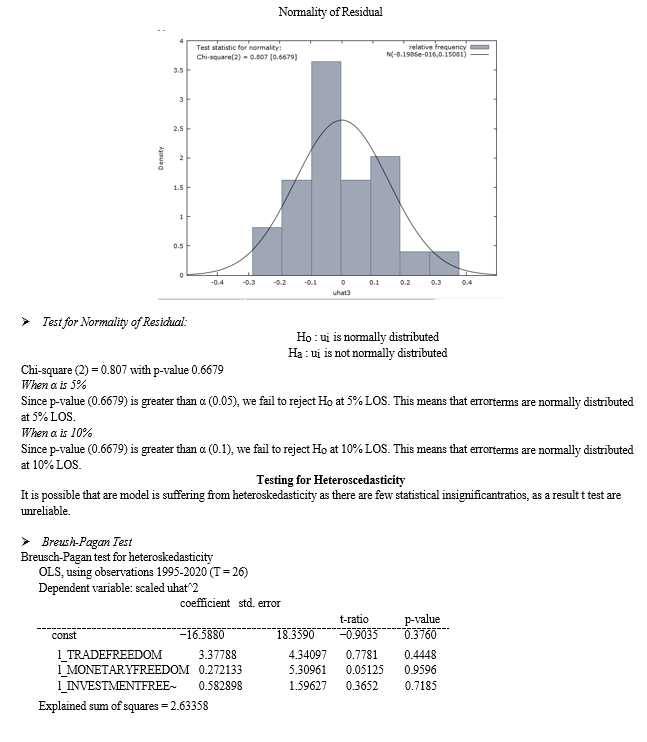


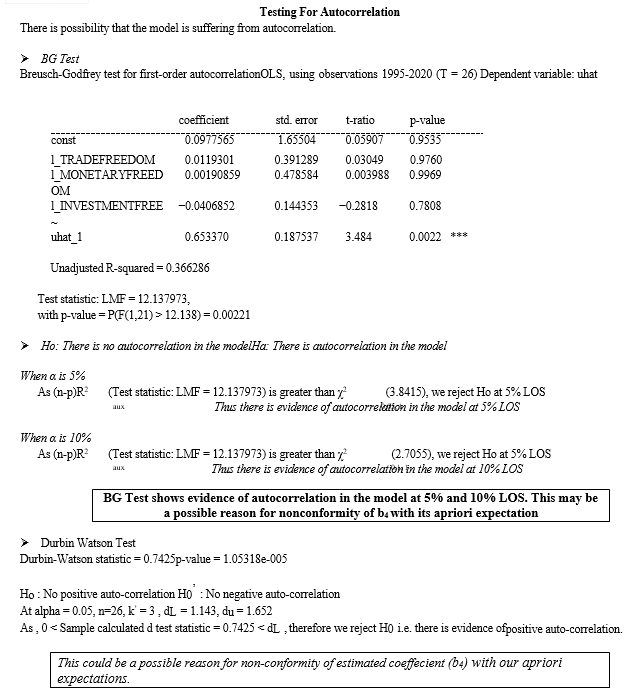
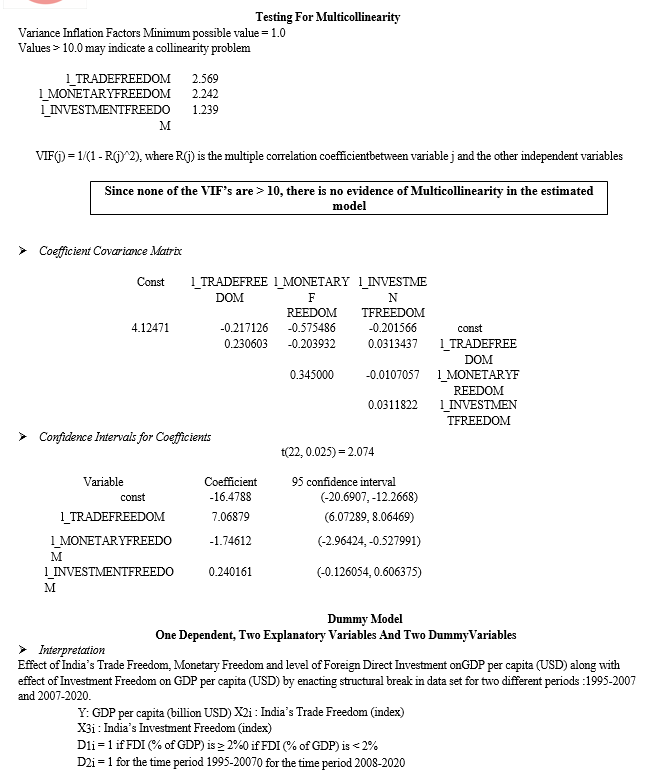
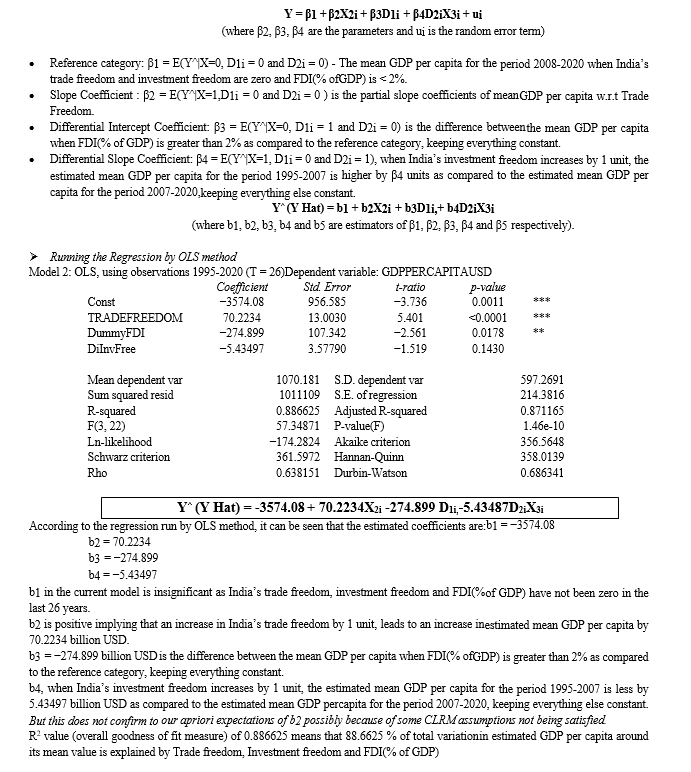
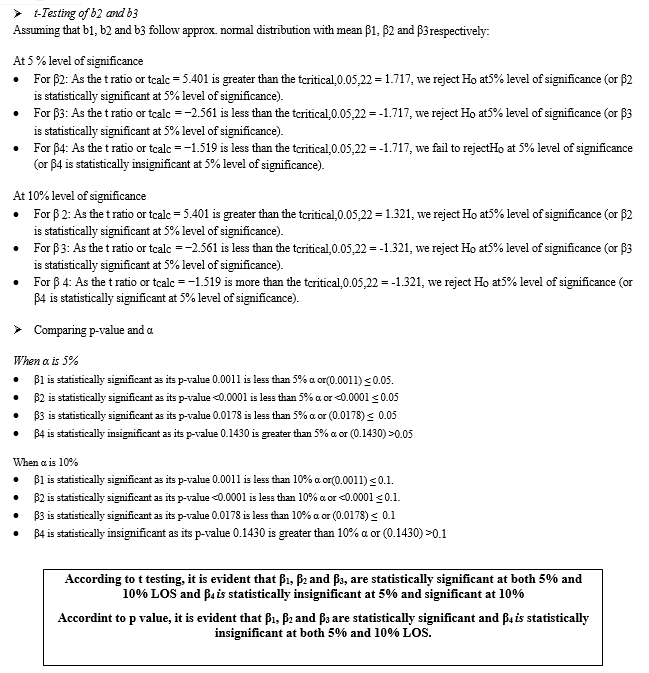
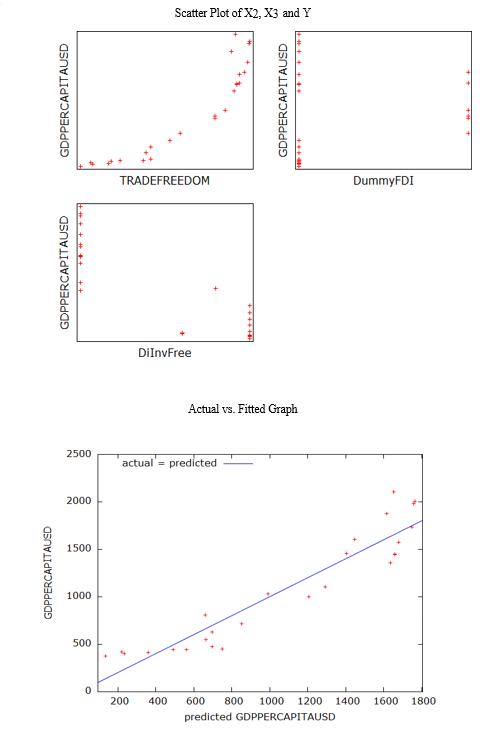
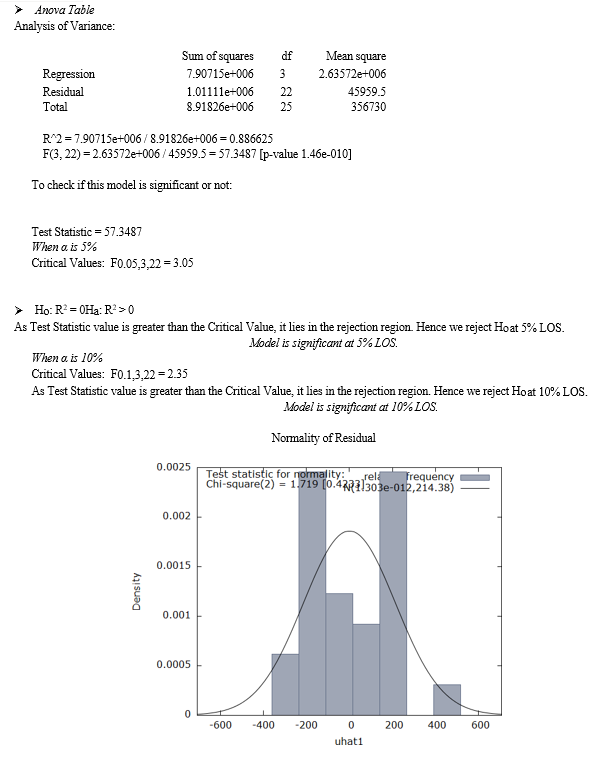
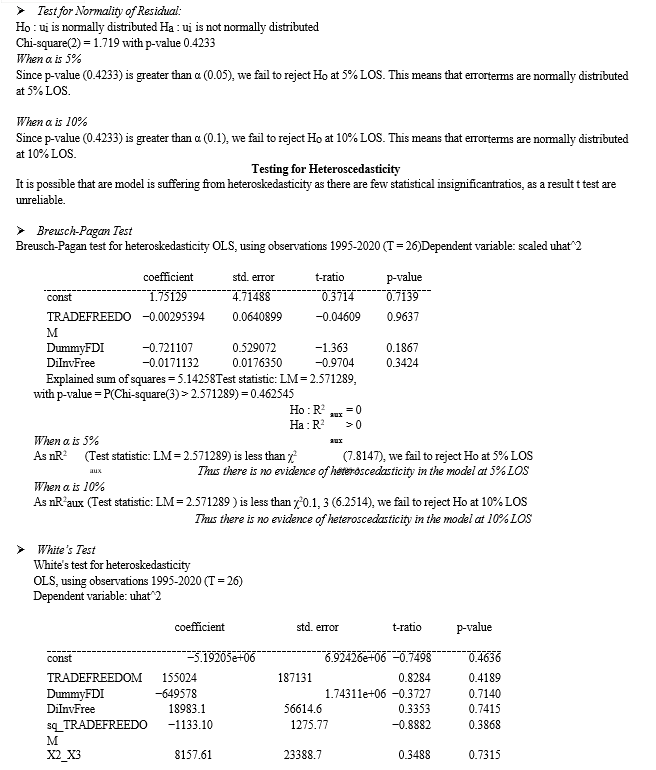
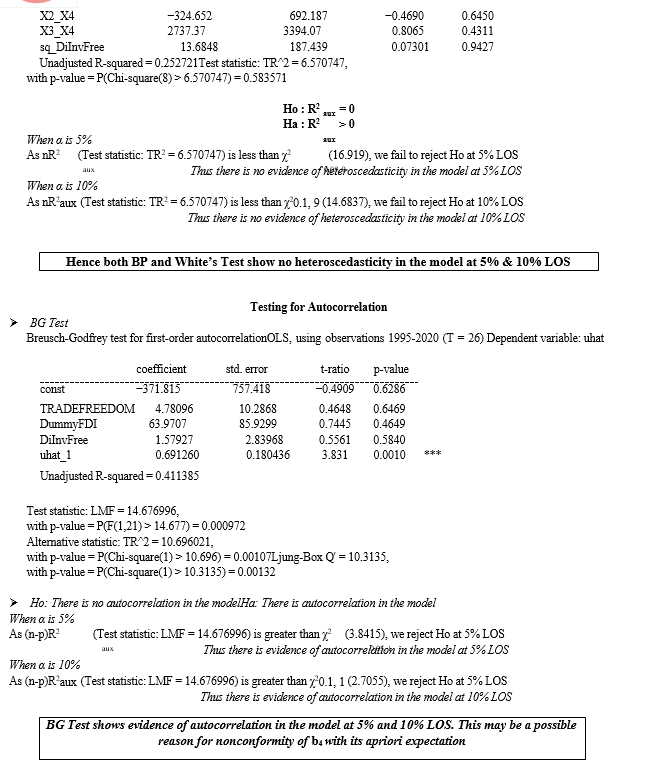
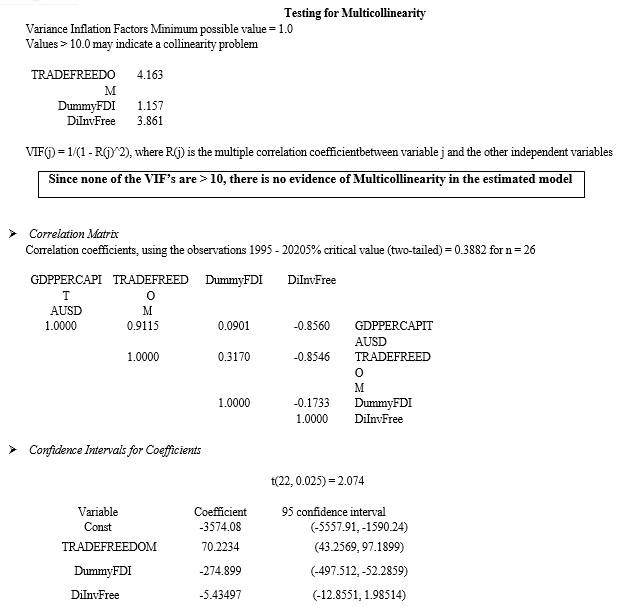
IX. DISCUSSION OF RESULTS & POLICY RECOMMENDATIONS
All things considered, we find compelling evidence that with lower levels of governmental regulation and fewer trade barriers along with substantial level of Foreign Direct Investment in the country lead to greater economic prosperity as measured by GDP per capita.
Perhaps the most interesting takeaway is that of the many variables experimented with during the model specification process, we ended up achieving the best results (on the basis of Schwartz Criterion) using only one of the original indices -- trade freedom. This suggests that of all the sectors in an economy, it is most critical for a nation to be open to international trade. It seems that in the absence of free trade nations struggle to achieve economic prosperity.
We set out to examine how economic freedoms influence GDP per capita and found that trade and to a lesser extent monetary freedom were explanatory of the dependent variable in all models while investment freedom ended up being insignificant in all models. However, in particular models, monetary freedom did not conform to our prior expectations.
Future work could consider even more aspects of an economy overall, including potential indices for variables such as taxation and presence of black markets. It could additionally control for more factors that influence GDP per capita, including health facilities, literacy level etc, to help capture more of the variance of the independent variable within the model.
In conclusion, the research has significant implications with respect to a nation’s economic policy and decision making. The primary goal of every governing entity is to maximize overall economic prosperity for its citizens. With lower barriers and fewer stringent economic policies, greater economic welfare can be achieved.
X. LIMITATIONS AND DIRECTIONS FOR FUTURE WORK
No work is free from limitations and this paper is no exception and thus the limitations need to be highlighted for better critical appreciation.
It was hard finding accurate data for the variables. Since we could not find appropriate data in our stipulated time frame for an important factor-Labour Freedom, this variable had to be dropped from our model.
The apriori expectations of the impact of Monetary Freedom were not matching with the regression results in the Multiple Linear and Double Log Regression Model, possibly due to CLRM assumption of No Autocorrelation not being satisfied, which could be rectified by using a larger database for more accurate result or by applying a ‘p’ period lag on the estimated equation (for model suffering from ARp)
Conclusion
This study analysed the impact of government regulations and trade barriers on India’s Overall Economic Wellbeing for 26 years from 1995-2020. The apriori expectations of the impact of Monetary Freedom were not matching with the regression results in the Multiple Linear and Double Log Regression Model, possibly due to CLRM assumption of No Autocorrelation not being satisfied. Residuals were normally distributed.
References
[1] https://data.worldbank.org/indicator/NY.GDP.PCAP.CD?locations=IN [2] https://www.heritage.org/index/visualize [3] https://www.heritage.org/index/monetary- freedom#:~:text=Monetary%20freedom%20combines%20a%20measure,state%20for%2 0the%20free%20market. [4] https://www.cato.org/sites/cato.org/files/serials/files/cato-journal/2012/7/v32n2-12.pdf [5] https://www.heritage.org/index/trade- freedom#:~:text=Trade%20freedom%20is%20a%20composite,%2Dtariff%20barriers%2 0(NTBs). [6] https://www.tandfonline.com/doi/full/10.1080/00130095.2017.1393312?src=recsys [7] https://www.heritage.org/index/country/india#:~:text=India\\\'s%20economic%20freedom%20score%20is,freest%20in%20the%202020%20Index.&text=India%20is%20ranked% 2028th%20among,the% [8] https://www.unescap.org/sites/default/files/impacts%20of%20trade%20facilitation.pdf [9] https://www.tandfonline.com/doi/full/10.1080/1331677X.2017.1305803 [10] https://www.heritage.org/index/trade- freedom#:~:text=Trade%20freedom%20is%20a%20composite,%2Dtariff%20barriers%2 0(NTBs). [11] https://www.economicshelp.org/blog/58802/trade/the-importance-of-international-trade/ [12] https://www.tandfonline.com/doi/full/10.1080/1331677X.2017.1305803
Copyright
Copyright © 2022 Aditi Das, Muskan Mohan, Nitya Sultania, Ishika Yadav. This is an open access article distributed under the Creative Commons Attribution License, which permits unrestricted use, distribution, and reproduction in any medium, provided the original work is properly cited.

Download Paper
Paper Id : IJRASET45592
Publish Date : 2022-07-13
ISSN : 2321-9653
Publisher Name : IJRASET
DOI Link : Click Here
 Submit Paper Online
Submit Paper Online

